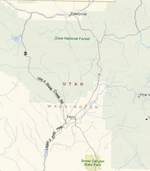 |
UTAH'S DIXIE HISTORICAL SITES
|
 |
 |
 |
 |
 |
 |
 |
| |
Where is it? |
 |
 |
|
|
|
GPS DATA: GRAFTON
PIONEER COMMUNITY 37' 35.423N
113' 49.524W Altitude 5543 ft In St. George, head North on Highway 18 to Enterprise, Utah. Turn West on Highway 120 and drive about 5.7 miles and turn right on Shoal Creek Road. (look for Sign) Follow Shoal Creek Road for about 1 miles to the Hebron Cemetery. |
|
.Hebron: Pioneer Settlement In March of 1862 the Pulsipher brothers, John, Charles, and William, in search of a more adequate feed ground for the new Dixie Mission herds, discovered the abundant untouched grass o f the Shoal Creek draining. The three brothers were part of the main pioneer company called the the fall of 1981 to help develop the Dixie Mission, and they had accepted the responsibility of caring for the growing pioneer herds. IN April of 1862 they moved their families to some lush springs at their first or lower settlements, three miles down Shoal Creek from the Hebron Pioneer Cemetery. During their first summer they were able to produce 3,000 pounds of butter and cheese, which was shared with the owners of the livestock. That fall they brought their aging father and family patriarch, Zerah Pulsipher, from Salt Lake City with the rest of the family, including a brother-in-law, Thomas S. Terry. In 1868, as other families join the little group, Apostle Erastus Snow and the county surveryor, George Burgon helped survey a new town site at the second or upper settlement on the broad flat one mile south of this cemetery. The new community was named Hebron after the Biblical heard ground established by Abraham in ancient Judea. Brick homes were built, trees and garden were planted, including an apple orchard that bore fruit well into the 1930sĖlong after the original pioneers were gone and Hebron was a memory. The community was formally organized in November of 1869 as the Hebron Ward of the church of Jesus Christ of Latter-day Saints, with George H. Crosby as bishop. For the rest of the century the members of this little pioneer community struggled with droughts, bloods, Indians, sickness, and other rigors of frontier life. Within this valley they lived, toiled, and died, and many of them are buried in the lonesome cemetery, which they permanently created in 1970. During the 1870s the little town was blessed with a mail route and telegraph line, connecting it to the mines of eastern Nevada, which provided a good market for produce and jobs for some of Hebronís people. But the life and growth of the community was restricted by its limited uncertain water supply. Combination of things finally brought about Hebronsís demiseĖ droughts, floods, an earthquake, and the vision and persistence of one of its own residents. It was Orson Welcome Huntsman who, despite years of opposition and discouragement, saw a much greater potential for Hebronís erratic water resource. Stored behind a high dam at the narrows of Little Pine Creek, it could be transferred to irrigate the limitless expanse of the Escalante Desert at the mouth of Shoal Creek, at the site of what would become the community of Enterprise. So in 1905, after nearly half a century of courageous struggle by these pioneers, the church bell rang for the last time in old Hebron before going moved to the new town of Enterprise, where it began to ring in a new day for a new generation
|
